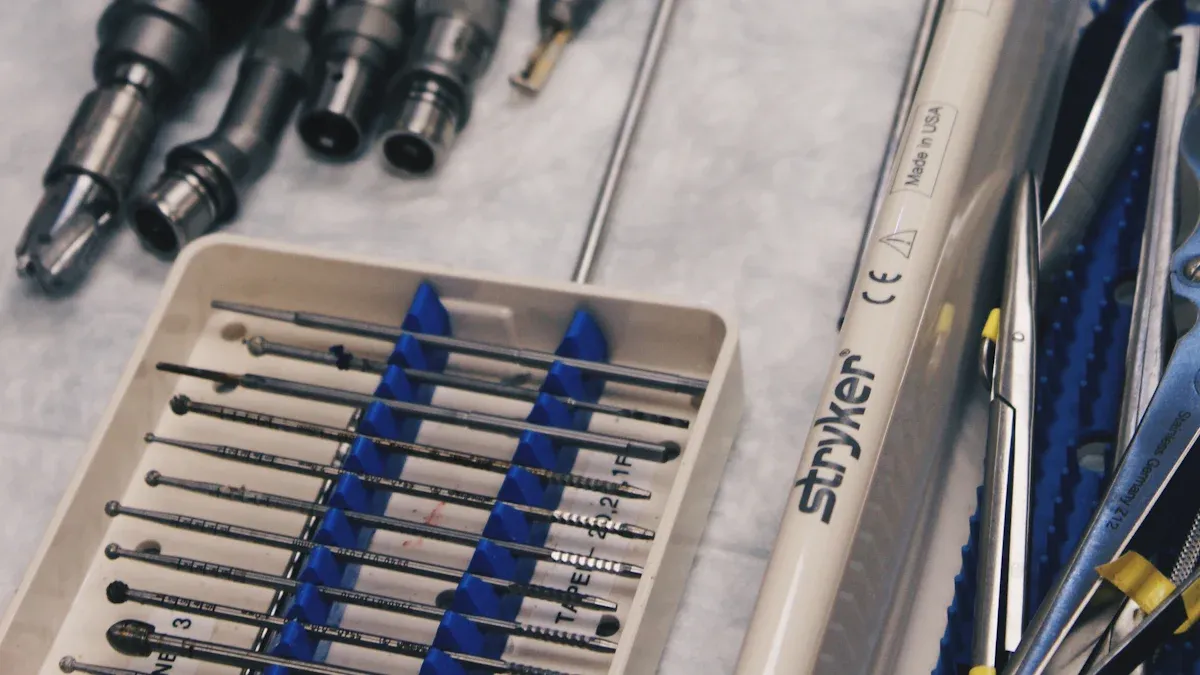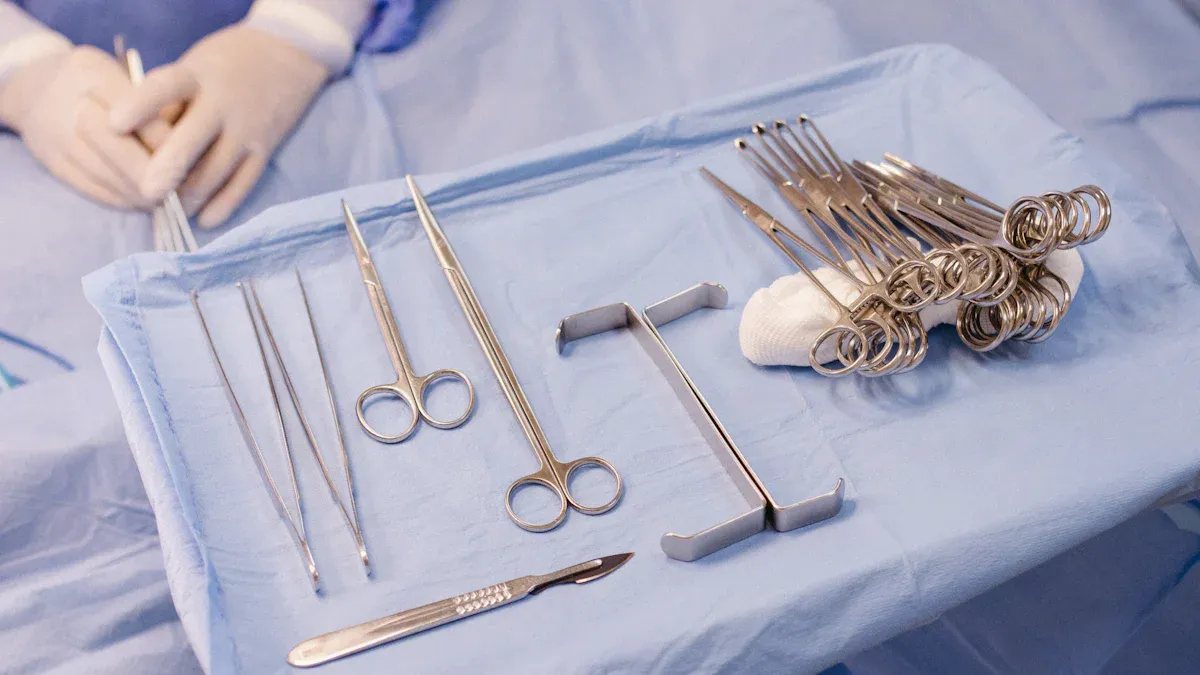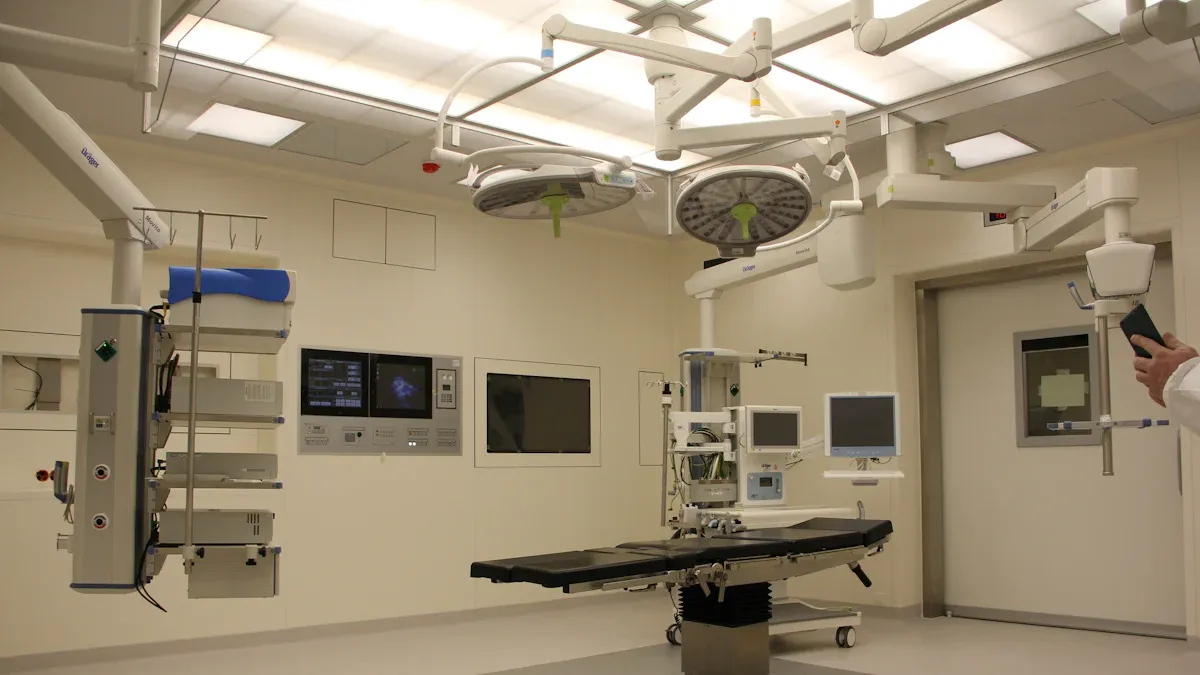Exploring the Role of Nitinol Tubing in Surgical Tools

Nitinol tubing brings unparalleled precision and adaptability to surgical instruments, transforming the field of minimally invasive procedures. Its exceptional manufacturing tolerances ensure accurate dimensions, which are crucial for delicate surgical tasks. For instance:
Tubing with an outer diameter (OD) over 0.80mm maintains a tolerance of ±0.005mm.
Diameters between 0.801-2.80mm allow a tolerance of ±0.010mm.
Tubing with ODs of 0.281-6.00mm and 6.010-12.00mm achieves tolerances of ±0.015mm and ±0.020mm, respectively.
This high precision enables smooth navigation through complex anatomies. Additionally, a study found that certain manufacturing techniques can extend the fatigue life of Nitinol tubing by up to three times, ensuring durability during repetitive use. By supporting minimally invasive techniques, Nitinol Tubing for Minimally Invasive Surgical Instruments significantly reduces patient discomfort and promotes faster recovery.
Key Takeaways
Nitinol tubing helps surgeons work precisely during delicate surgeries.
It can change shape and bend easily, fitting complex body parts.
Nitinol is safe for the body and doesn’t rust, lowering risks.
It is strong and doesn’t bend permanently, even under pressure.
Using Nitinol in small cuts helps patients heal faster and feel better.
Unique Properties of Nitinol Tubing for Minimally Invasive Surgical Instruments

Shape Memory and Superelasticity
Nitinol tubing for minimally invasive surgical instruments owes much of its adaptability to its shape memory and superelasticity. These properties allow the material to return to its original shape after deformation, making it ideal for complex surgical applications. For instance, shape memory enables instruments to "remember" a pre-set configuration when exposed to body heat, ensuring precise performance during procedures. Superelasticity, on the other hand, allows the tubing to withstand significant bending and stretching without permanent deformation.
Property | Description |
|---|---|
Shape Memory Effect | The ability of the material to return to a 'remembered' shape when heated, allowing for precise instrument design. |
Superelasticity | The capacity to recover from large deformations, providing flexibility and resilience in surgical applications. |
Applications | Nitinol's unique properties enable its use in devices like organ frame retractors, enhancing surgical performance. |
These characteristics make nitinol tubing indispensable in minimally invasive procedures, such as angioplasty and stent delivery. Its ability to navigate intricate anatomical pathways without kinking ensures smooth operation and reduces the risk of complications.
Biocompatibility and Corrosion Resistance
Exceptional biocompatibility and corrosion resistance are critical for materials used in surgical instruments. Nitinol tubing excels in both areas, making it a preferred choice for minimally invasive surgical tools. Its biocompatibility ensures that it interacts safely with human tissues, minimizing the risk of adverse reactions. Additionally, its resistance to corrosion enhances its durability, even in the challenging environment of the human body.
Studies, such as those by Rahimipour et al. (2020) and Ryhänen et al. (1997), confirm nitinol's biocompatibility and corrosion resistance. These findings highlight its suitability for long-term use in medical devices.
Study | Focus | Findings |
|---|---|---|
Rahimipour et al. (2020) | Corrosion and biocompatibility | Discusses the impact of surface treatment on corrosion resistance and biocompatibility assessments. |
Ryhänen et al. (1997) | Biocompatibility and corrosion | Evaluates the biocompatibility of Nitinol in human cell cultures and its corrosion behavior. |
FDA Guidance (2016) | Biocompatibility standards | Outlines established test standards for assessing biocompatibility in medical devices. |
ISO 10993-1 (2018) | Biological evaluation | Provides guidelines for biological evaluation and testing of medical devices. |
Sivan et al. (2017) | Corrosion and structural integrity | Investigates how corrosion can lead to structural integrity issues in Nitinol implants. |
This combination of biocompatibility and corrosion resistance ensures that nitinol tubing maintains its structural integrity and performance over time, making it a reliable choice for surgical applications.
Durability and Kink Resistance
Durability and kink resistance are essential for surgical instruments that must perform under demanding conditions. Nitinol tubing demonstrates remarkable durability, withstanding repeated use without compromising its structural integrity. Its kink resistance ensures that the tubing maintains its shape and functionality, even when navigating tight or complex anatomical pathways.
Nitinol's superelastic properties contribute significantly to its kink resistance. This flexibility allows surgical instruments to bend around obstacles without permanent deformation. As a result, nitinol tubing for minimally invasive surgical instruments provides consistent performance, reducing the likelihood of instrument failure during critical procedures.
The structural integrity of nitinol tubing also enhances its longevity. Research shows that certain manufacturing techniques can triple its fatigue life, ensuring that it remains reliable even after extensive use. This durability makes it an invaluable material for tools used in minimally invasive surgeries, where precision and reliability are paramount.
Applications of Nitinol Tubing in Minimally Invasive Procedures
Stents and Vascular Implants
Nitinol tubing plays a pivotal role in the development of stents and vascular implants, which are essential for treating conditions like arterial blockages and aneurysms. Its shape memory and superelasticity allow stents to expand precisely within blood vessels, ensuring optimal placement and functionality. These properties also enable vascular implants to adapt to dynamic anatomical changes, maintaining their effectiveness over time.
Clinical trials validate the reliability of nitinol-based stents. For example, the ORION trial evaluated the EPIC™ Self-Expanding Nitinol Stent System across 123 patients at 25 sites. The study assessed major adverse events (MAE) over nine months, confirming the device's safety and efficacy.
Trial Name | Device | Patient Enrollment | Major Adverse Events (MAE) | Duration |
|---|---|---|---|---|
ORION | EPIC™ Self-Expanding Nitinol Stent System | 123 patients at 25 sites | Evaluated at 9 months | 9 months |
These findings highlight nitinol's transformative impact on minimally invasive procedures, particularly in vascular applications. Its ability to conform to complex anatomical structures reduces the risk of complications and enhances patient outcomes.
Catheters and Guidewires
Catheters and guidewires benefit significantly from nitinol tubing's unique properties. Shape memory ensures that these devices adapt seamlessly to the anatomy, enhancing precision during complex procedures. Superelasticity allows them to endure stress and return to their original shape, improving durability and reliability.
Property | Benefit |
|---|---|
Shape Memory | Allows devices to adapt to the anatomy, enhancing precision in complex procedures. |
Superelasticity | Enables the tubing to withstand stress and return to its original shape, improving durability. |
Biocompatibility | Reduces risk of adverse reactions, crucial for long-term implants. |
Fatigue Resistance | Ensures longevity by enduring millions of cycles without failure. |
Mechanical Strength | Maintains structural integrity under repeated stress, essential for guidewires and catheters. |
Nitinol tubing enhances flexibility, enabling guidewires to navigate tortuous vascular pathways without kinking. This flexibility minimizes patient trauma during minimally invasive procedures, making nitinol an indispensable material for surgical tools. Nitinol wire, often combined with stainless steel, further improves the functionality of guidewires by ensuring structural integrity under repeated stress. These advantages underscore nitinol's critical role in advancing catheter and guidewire technology.
Robotic-Assisted Surgical Tools
Robotic-assisted surgical tools rely on nitinol tubing to achieve precision and adaptability in minimally invasive procedures. Nitinol's superelasticity allows robotic instruments to maneuver through complex anatomical pathways with ease. Its durability ensures consistent performance during repetitive movements, which is crucial for robotic systems.
Robotic-assisted tools equipped with nitinol tubing enhance surgical accuracy by providing surgeons with greater control over instrument placement. This precision reduces the risk of complications and improves patient outcomes. Additionally, nitinol's biocompatibility ensures that these tools interact safely with human tissues, making them ideal for delicate procedures.
AccuPath, a leader in nitinol tubing manufacturing, continues to innovate in this field, providing high-quality materials for robotic-assisted surgical tools. Their commitment to precision and reliability supports the advancement of minimally invasive procedures, ultimately benefiting patients and healthcare providers alike.
Precision and Adaptability in Surgical Instruments
Enhanced Control in Complex Anatomies
Nitinol tubing enhances control in surgical instruments, especially when navigating complex anatomical pathways. Its superelasticity allows tools to bend and flex without losing structural integrity, ensuring smooth operation during delicate procedures. This flexibility is vital for instruments like guidewires and catheters, which must maneuver through tight spaces while maintaining stability.
Evidence Description | Key Contribution to Reliability |
|---|---|
Nitinol's durability and precision are critical for the success of minimally invasive procedures. | Exceptional resistance to fatigue ensures structural integrity under repeated use, vital for guidewires and catheters. |
Nitinol enhances the precision and flexibility of medical devices. | Superelasticity and shape memory properties allow navigation through complex pathways, reducing procedural errors. |
Exceptional flexibility improves device performance. | Allows bending through tight spaces while maintaining stability, crucial for precision in delicate interventions. |
These properties make nitinol tubing indispensable for surgical tools designed for complex anatomies. Its adaptability ensures that surgeons can perform intricate procedures with greater confidence and accuracy.
Improved Navigation and Placement Accuracy
Nitinol tubing improves navigation and placement accuracy in surgical tools. Its shape memory property enables instruments to return to their pre-set configurations, ensuring precise placement during procedures. This characteristic is particularly beneficial for devices like stents and catheters, which require accurate positioning to function effectively.
Enhanced navigation and maneuverability during medical procedures.
Precise placement and movement within the body due to flexibility and shape memory properties.
Improved patient comfort and safety leading to better overall outcomes.
By reducing procedural errors, nitinol tubing contributes to better surgical outcomes. Its adaptability allows surgeons to navigate challenging anatomical structures with ease, minimizing the risk of complications.
Reduced Risk of Surgical Complications
Surgical tools equipped with nitinol tubing reduce the risk of complications during procedures. The material's durability ensures consistent performance, even under repeated stress. Its biocompatibility minimizes adverse reactions, making it safe for use in the human body.
Nitinol's kink resistance further enhances its reliability. Instruments made from nitinol tubing maintain their shape and functionality, even when navigating tight or tortuous pathways. This stability reduces the likelihood of device failure, ensuring smoother procedures and better patient outcomes.
Nitinol tubing's combination of precision, adaptability, and durability makes it a cornerstone of modern surgical tools. Its ability to enhance control, improve navigation, and reduce complications underscores its transformative impact on healthcare.
Improved Patient Comfort and Outcomes with Nitinol Tubing

Faster Recovery Times
Nitinol tubing significantly contributes to faster recovery times for patients undergoing minimally invasive procedures. Its flexibility allows surgical tools to navigate complex anatomical pathways with minimal disruption to surrounding tissues. This reduces trauma during procedures, leading to quicker healing and improved patient experiences. Nitinol's biocompatibility further enhances recovery by minimizing the risk of inflammation or rejection, ensuring smoother post-operative outcomes.
Nitinol tubing enables less invasive techniques, prioritizing patient comfort.
Its adaptability to body movements reduces trauma, contributing to faster recovery times.
Reliable device performance minimizes complications, enhancing recovery outcomes.
The use of nitinol in medical devices also supports smaller incisions and faster recovery, making it a preferred material for modern surgical tools. Patients benefit from reduced pain levels and lower risks of complications, as demonstrated in clinical recovery data:
Metric | Nitinol Devices | Traditional Materials |
|---|---|---|
Recovery Improvement | 20% | N/A |
Pain Level Reduction | Quicker recovery | N/A |
Risk of Complications | Lower | N/A |
These advantages highlight nitinol's transformative role in improving recovery outcomes for patients.
Minimally Invasive Techniques and Reduced Scarring
Minimally invasive techniques rely on nitinol tubing to achieve precision and adaptability during procedures. Its shape memory and superelasticity allow surgical tools to perform effectively through smaller incisions, reducing scarring and promoting faster healing. Nitinol's flexibility ensures that devices can navigate tight anatomical spaces without causing unnecessary damage to surrounding tissues.
Nitinol tubing's ability to support minimally invasive techniques leads to improved patient comfort and outcomes. Smaller incisions result in less visible scarring, while reduced tissue trauma enhances recovery times.
Patients undergoing procedures with nitinol-based devices experience fewer complications and better aesthetic results. These benefits make nitinol tubing indispensable for surgical tools designed for minimally invasive applications.
Long-Term Reliability of Implants
Nitinol tubing ensures the long-term reliability of implants used in minimally invasive surgeries. Its durability allows devices to withstand repeated stress without compromising their structural integrity. Biocompatibility ensures that implants interact safely with human tissues, reducing the risk of adverse reactions over time.
Nitinol's corrosion resistance further enhances the longevity of implants, making it ideal for devices that remain in the body for extended periods. The material's adaptability to dynamic anatomical changes ensures consistent performance, even under challenging conditions. Patients benefit from fewer device failures and improved outcomes, reinforcing nitinol's value in surgical applications.
The combination of durability, biocompatibility, and corrosion resistance makes nitinol tubing a cornerstone of reliable medical implants. Its ability to maintain functionality over time supports better patient outcomes and long-term comfort.
Future Innovations in Nitinol Tubing for Healthcare
Advancements in Smart Surgical Technologies
Emerging technologies are transforming the use of nitinol in healthcare. Smart surgical tools now integrate nitinol tubing to enhance precision and adaptability. The material's shape memory and superelasticity allow instruments to perform complex movements with minimal effort. These properties are particularly valuable in robotic-assisted surgeries, where precise control is essential.
Artificial intelligence (AI) is also revolutionizing nitinol device design. AI enables the creation of personalized solutions tailored to individual patient needs. For example, stents and orthodontic wires can now be optimized for fit and performance. This innovation improves safety and functionality, ensuring better outcomes for patients.
Nitinol's unique properties make it indispensable for smart surgical technologies. Its ability to adapt to body movements while maintaining durability ensures consistent performance during procedures.
Application Area | Key Benefits |
|---|---|
Minimally Invasive Surgery | Shape memory enhances accuracy; superelasticity aids navigation; biocompatibility reduces complications; corrosion resistance improves longevity. |
Wearable Medical Devices | Flexibility and biocompatibility make it suitable for sensors and drug delivery systems, adapting to body movements while ensuring durability. |
AI Integration in Device Design | AI enables personalized designs for Nitinol devices, optimizing fit and performance based on patient-specific data. |
Expanding Applications in Non-Surgical Medical Devices
The flexibility and durability of nitinol tubing have expanded its applications beyond surgical tools. Wearable medical devices, such as sensors and drug delivery systems, now utilize nitinol for its adaptability and biocompatibility. These devices can conform to body movements while maintaining their structural integrity.
The cardiovascular sector has seen significant growth in non-surgical devices using nitinol. This trend is driven by the rising prevalence of chronic diseases and advancements in medical technology. Nitinol's properties make it ideal for minimally invasive procedures, which are increasingly in demand. Its corrosion resistance and long-term reliability ensure that these devices perform effectively over time, improving patient care.
Potential for Customizable and Patient-Specific Solutions
Customization is a key area of innovation for nitinol tubing. The material's ability to undergo a phase transformation between austenite and martensite allows for tailored designs. This transformation enables superelasticity, which is crucial for implants like stents. These devices must be crimped for insertion and then expanded without permanent deformation.
Tailored nitinol tubing enhances device performance by meeting specific anatomical and clinical needs. For example, customized stent designs improve outcomes for patients with complex vascular conditions. Adjustments in dimensions and mechanical properties optimize these devices for their intended applications.
Key Point | Description |
|---|---|
Adaptability | Nitinol tubing can be tailored to meet specific anatomical and clinical needs, enhancing device performance. |
Patient Outcomes | Customized stent designs lead to improved patient outcomes, particularly in complex vascular conditions. |
Mechanical Properties | Customization allows for adjustments in dimensions and mechanical properties, optimizing stents for specific applications. |
Nitinol's versatility continues to drive advancements in patient-specific solutions, ensuring that medical devices meet the unique needs of each individual.
Nitinol tubing has revolutionized the design of surgical tools by enhancing precision and adaptability. Its unique properties, such as shape memory and superelasticity, allow medical devices to perform with unmatched accuracy. These qualities make nitinol indispensable in minimally invasive procedures, where precision is critical for success.
The material also plays a vital role in improving patient outcomes. Its biocompatibility and durability reduce complications, while its flexibility supports faster recovery and less visible scarring. Patients benefit from safer procedures and long-term reliability of implants.
Looking ahead, nitinol holds immense potential in medical innovations. Advancements in smart surgical technologies and patient-specific solutions will further expand its applications. As healthcare evolves, nitinol will remain a cornerstone of progress, driving better tools and improved care.
FAQ
What makes Nitinol tubing unique for surgical tools?
Nitinol tubing stands out due to its shape memory and superelasticity. These properties allow it to return to its original shape after deformation and endure significant stress without damage. Its biocompatibility and corrosion resistance further enhance its suitability for medical applications.
How does Nitinol tubing improve patient outcomes?
Nitinol tubing supports minimally invasive procedures, reducing tissue trauma and scarring. Its flexibility and durability ensure reliable device performance, leading to faster recovery times and fewer complications. Patients experience improved comfort and long-term implant reliability.
Can Nitinol tubing be customized for specific medical needs?
Yes, Nitinol tubing can be tailored for patient-specific solutions. Adjustments in dimensions and mechanical properties allow it to meet unique anatomical and clinical requirements. This customization enhances the performance and effectiveness of medical devices like stents and implants.
Is Nitinol tubing safe for long-term use in the body?
Nitinol tubing is highly biocompatible and resistant to corrosion, making it safe for long-term use. Its durability ensures that implants maintain structural integrity over time, reducing the risk of failure and adverse reactions.
What role does Nitinol play in robotic-assisted surgeries?
Nitinol tubing enhances robotic-assisted surgical tools by providing flexibility and precision. Its superelasticity allows instruments to navigate complex anatomical pathways with ease. This adaptability improves surgical accuracy and reduces the risk of complications during minimally invasive procedures.
See Also
Nitinol Tubing's Impact on Modern Medical Innovations
Nitinol Tubing Uses in Cutting-Edge Healthcare Equipment
The Importance of Nitinol Tubing in Less Invasive Surgery
Nitinol Tubing's Transformative Effect on Medical Equipment
The Critical Role of Nitinol Tubing in Healthcare Technology

